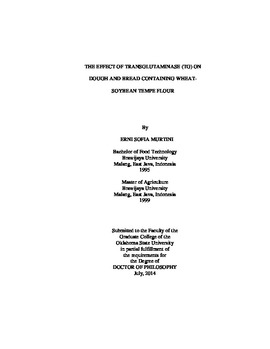| dc.contributor.advisor | Rayas-Duarte, Patricia | |
| dc.contributor.author | Murtini, Erni Sofia | |
| dc.date.accessioned | 2015-06-17T20:07:15Z | |
| dc.date.available | 2015-06-17T20:07:15Z | |
| dc.date.issued | 2014-07 | |
| dc.identifier.uri | https://hdl.handle.net/11244/15034 | |
| dc.description.abstract | Consumer's need for good quality and healthy products are also applicable to wheat baked products. Variation of gluten protein quality and the limiting amino acid lysine from the nutritional point of view are two challenges of wheat flour. Gluten protein can be modified by transglutaminase (TG) and improvement of desirable product properties can be designed with the right treatment dose. Tempe, a fermented soy/grain, provides healthy components such as isoflavones, bioactive peptides, vitamins and high lysine content. This study was aimed to measure the effect of TG on gluten, dough and baking properties. A set of six commercial wheat flours with protein content (11.0+-0.5) was treated with TG (0; 0.1; 0.2; 0.4; 0.8; 1.6 % w/w flour basis) based on randomized complete block design with 3 replications. Results indicated that wet gluten decreased while gluten index and elastic recovery increased with increasing TG levels. Addition of mixing and resting dough prior to the gluten extraction positively increased wet gluten and gluten elastic recovery. At level of 0-0.4%, TG positively increased farinograph development time and stability, decreased amount of CO2 release during dough fermentation, increased the coefficient of gas retention and produced finer bread crumb structure. However, at 0.8% TG, excessive formation of covalent bonds dramatically decreased dough rheological properties, Hm and bread volume and increased crumb texture hardness. | |
| dc.description.abstract | The study was also aimed to prepare tempe wheat-soy flour and to analyze the effect of TG and tempe flour on rheological and fermentation properties of composite flour. A desirable tempe cake and lysine content closest to WHO standard lysine requirement for adults was obtained with wheat: soy at 1:1 ratio (w/w). Substitution tempe flour at 0, 10, 20, 30 and 40% in wheat flour treated with TG (0, 0.05 and 0.1%) significantly influenced most of the mixing and fermentation properties of composite flour. It increased development time, stability and breakdown time and decreased CO2 lost during fermentation. Tempe flour up to 20% did not change gaseous release. This study suggests that composite flours using up to or less than 20% tempe can be used in bread formulation using 0.1% TG. | |
| dc.format | application/pdf | |
| dc.language | en_US | |
| dc.rights | Copyright is held by the author who has granted the Oklahoma State University Library the non-exclusive right to share this material in its institutional repository. Contact Digital Library Services at lib-dls@okstate.edu or 405-744-9161 for the permission policy on the use, reproduction or distribution of this material. | |
| dc.title | Effect of transglutaminase (TG) on dough and bread containing wheat-soybean tempe flour | |
| dc.contributor.committeeMember | McGlynn, William G. | |
| dc.contributor.committeeMember | Bowser, Tim | |
| dc.contributor.committeeMember | Maness, Niels O. | |
| dc.contributor.committeeMember | Payton, Mark E. | |
| osu.filename | Murtini_okstate_0664D_13468.pdf | |
| osu.accesstype | Open Access | |
| dc.type.genre | Dissertation | |
| dc.type.material | Text | |
| dc.subject.keywords | bread | |
| dc.subject.keywords | dough | |
| dc.subject.keywords | transglutaminase | |
| dc.subject.keywords | wheat flour | |
| dc.subject.keywords | wheat-soy tempe | |
| thesis.degree.discipline | Food Science | |
| thesis.degree.grantor | Oklahoma State University | |
